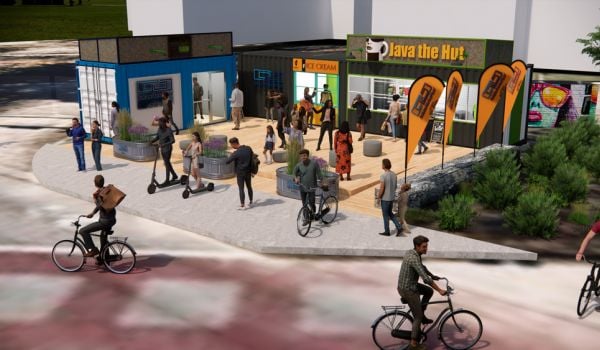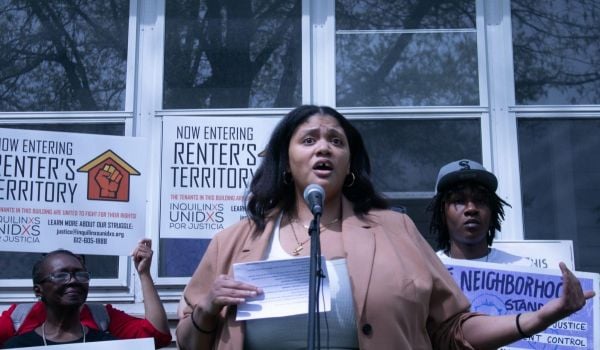As winter sets in and the coats come out in Minnesota, so does a perennial debate: What should Minneapolis do about its skyways? A recent zoning change is attempting to make the indoor walkways more accessible to all, while a citizen-led initiative is encouraging people to abandon the skyways and return to the streets. City officials, downtown business leaders, urban designers and many citizens agree the skyways have been both a blessing and a curse, but no clear answer has emerged for how a relic of the 20th century can be modified for the needs of today.
One thing is certain: In the ’60s, the burgeoning network of skyways likely saved downtown. Businesses linked up with these floating walkways that allowed people to pass building to building without going out in the cold. At a time when suburban malls and office parks were flourishing, they were seen as an innovative solution for a wintry city. Over the next five decades, the network grew to approximately 9 miles, the longest such system in the world.
But as people return downtown not only to work in office buildings but also to live, shop, dine and play, the skyways are sapping vitality from the street level. Though they’re public, they’re hard to navigate, and some argue they create a divided city: the haves, floating, warm above, and the have-nots cold below.
So far, the city’s solution has been to rewrite skyway guidelines. The walkways are privately built and owned, but they are open to the public, require an encroachment permit, and if they’re connected to the overall system, they garner property owners a floor area bonus. For the first time this year, the city codified existing recommendations into amendments to the zoning code with the purpose of “ensur[ing] the design of skyways contributes to the built and natural environment.”
The zoning changes cover basics like safety, lighting and visibility (skyways are required to have large windows for crime prevention) as well as some unexpected factors. As of this year, new skyways are required to use patterned glass or glazing that’s more visible to birds.
The new code also requires companies to create clear directional signage for how to get into the skyways and navigate between them.
“It can be difficult when you are on the street to see where the access points are to get into the skyway system,” says Jason Wittenberg, manager of land use, design and preservation in the city’s Development Services Division. That could be a real problem when the Super Bowl comes to town in 2018. Downtown Minneapolis has over 90 skyways, and they don’t just cross streets. They run through buildings, linking up to all manner of businesses: banks, hotels, some even run through department stores. They’re not intuitive for locals, and might be near impossible for visitors to navigate.
Under the new guidelines, new skyways need clearly defined public entrances, exterior signage noting their location, and must remain open to the public for set hours on weekdays and weekends. These are encouraged for adoption in all skyways, but the code changes apply only to new ones. Which assumes there will be new ones. Wittenberg says lately approximately one new skyway has been built a year. In adopting these changes, the city has essentially conceded to the same argument made by the Star Tribune last week: “Skyways are here to stay, but there’s room for improvement,” the headline read.
Eric Dayton, Minneapolis resident and son of Minnesota’s governor, disagrees. His great-great-grandfather founded Dayton’s department store, which later became Target. Dayton’s downtown Minneapolis location is now a Macy’s that has announced it’s looking for buyers. Though the original skyway boom might have stopped businesses from relocating to suburban corporate campuses, Dayton has watched countless retailers leave Minneapolis’ downtown core in recent years. When a journalist suggested today’s Dayton’s buy back the Macy’s building and use it to bring back some downtown vibrancy, Eric said he’d be game — if the skyways were gone.
A conversation was sparked. “Is downtown Minneapolis a good environment for investment right now? Do the skyways create structural headwind for retail in downtown Minneapolis?” Dayton asks. “I would argue that it does. As long as they’re in place, that makes me unfortunately not inclined to invest downtown.”
And he is investing elsewhere. His family owns a restaurant, cocktail bar and a men’s clothing store in the North Loop, where skyways aren’t allowed. City policy restricts them to the downtown area. Dayton wants to see them reconsidered altogether.
“I disagree with those who just accept that we’re stuck with them forever,” he says. “If we think that they’re bad for downtown, and if in fact we know that they’re bad for downtown, then let’s have the courage of our convictions to really do something about it.” Adding wayfinding signage only makes them “a little less bad,” he argues.
So far, he’s fighting the scourge one person at a time. Dayton founded the Skyway Avoidance Society, which asks people to take a pledge that they will walk the sidewalks, not the skyways, in an attempt to bring vitality back to street level. Members get a 10 percent discount on outerwear at Dayton’s store, but he says that’s not what this is about. The skyways “aren’t necessary,” he says. Plenty of cold cities do without them. Minneapolis can too. Dayton wants to make people aware of the consequences of continuing to use the skyways: disappearing retail on the dead street below.
“We recognize that skyways have the potential to take some life off of the streets,” says Wittenberg. “Our overall policy is that we want skyways to be largely confined to the downtown core and to connect to certain other major centers of activity and not to extend into adjacent neighborhoods or historic districts.” The city is currently rewriting its comprehensive plan, which might include altering policy to continue to encourage skyways or not.
For the time being, Minneapolis residents have a choice. Stick to the skies, or take to the streets.
Jen Kinney is a freelance writer and documentary photographer. Her work has also appeared in Philadelphia Magazine, High Country News online, and the Anchorage Press. She is currently a student of radio production at the Salt Institute of Documentary Studies. See her work at jakinney.com.
Follow Jen .(JavaScript must be enabled to view this email address)
















